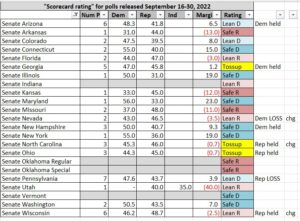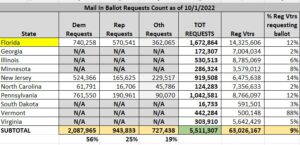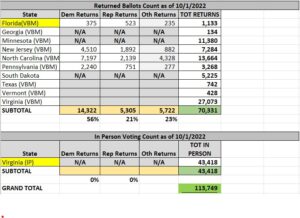America is now in the midst of election season and are therefore focusing on House, Senate, Governor’s, and other races that will be on the November 8 ballot. In fact, in several states, people are actually early voting in person (November 8 in Louisiana is a PRIMARY day, although any candidate who receives at least 50% of the vote will be “elected” that night).
And while people are tuning into the races now, polling has increased in frequency – from 116 poll results in early September to 170 in the latter half. JMC will focus on U.S. Senate races today.
Scorecard Criteria
Publicly available polling data for all Senate races has been compiled from September 16-30, and since we also have available polling data for both late August and the first half of September (when people DID start to focus on elections), we have some trends that can be determined across the country. As polling data is compiled for a given time period, it is then averaged for each Senate race, and with the average poll showing for each candidate, here’s how JMC rates each race:
(1) Safe Democratic/Republican – A candidate either has a polling average of at least 50% and/or at least a 10-point lead in the polls;
(2) Lean Democratic/Republican – A candidate has a 3–9-point lead in the polls;
(3) Tossup – A candidate’s lead is less than 3 points in the polls;
JMC’s 10/2 Scorecard
Given those criteria, this is the “state of the US Senate” as of the writing of this article (and based on September 16-30 polling data consisting of 51 Senate race polls):
Aggregate Dashboard statistics
- Biden job approval: 54-43% Disapprove (no change since 9/16)
- Congressional job approval: 59-22% Disapprove (was 57-24% disapprove)
- Generic congressional vote: 45-45% Democratic/Republican (was 44-43% Democratic)
- Direction of country: 65-29% wrong direction (was 65-28% wrong direction)
Senate race statistics
- Current: 50 Democrats, 50 Republicans
- Polling average: 49 Democrats, 48 Republicans, 3 Tossups (2 Republican seats, 1 Democratic seats) (was 49-47 Democratic)
- Net pickup: NONE (was +1 Democratic net gain in previous analysis)
Commentary: Since the last scorecard, there have been three ratings changes, and those changes marginally benefit the Republicans:
- Nevada Senate: from “Tossup” to “Leans Republican” – Democratic Senator Catherine Cortez-Masto has seen a steady erosion in her support. In late August, she led 46-44, when then became a 45-45 tie two weeks ago. Now she TRAILS 43-47% against her Republican challenger. If this polling deficit holds, it would be a Republican pickup;
- North Carolina Senate: from “Leans Republican” to “Tossup” (this is an open seat held by a Republican), as the Republican candidate went from a 1-point poll deficit in late August to a 3-point lead in mid September. Now, that lead has slipped to a 1 point lead;
- Wisconsin Senate: from “Tossup” to “Leans Republican” – this race has shifted 7 points towards Senator Ron Johnson in a month’s time. In late August, he trailed 46-50%, then his showing improved to 49-48% two weeks ago. His current poll average is 49-46%, and two of the most recent polls conducted late last week showed him above 50%;
- Republicans have also seen notable poll movement in the Pennsylvania Senate race (an open Republican seat). As recently as two weeks ago, Dr. Oz (the Republican nominee) trailed 44-51%, in the latest average of polls, he has narrowed the gap and trails 44-48%. Not quite enough for JMC to reclassify as a “tossup”, but still worth noting;
- The Georgia and Ohio races remain in tossup status, while in Arizona, Democratic Senator Mark Kelly remains ahead in a lead that has fluctuated from between 4 and 6 points;
- Now that New Hampshire has held its primary, initial polling shows Democratic incumbent Maggie Hassan comfortably ahead, so for now, that seat is rated as “Safe Democratic.”
Overall, polling results since early September show a slight and consistent “reddening.” Will this trend continue ? We will revisit this topic in a couple of weeks.
Early voting
While it is true that Election Day isn’t until November 8, in person early voting has already started in eight states (Illinois, Michigan, and Virginia are the latest bigger states that are in person early voting now), while other states (such as Florida, Illinois, New Jersey, North Carolina, and Pennsylvania) have sent out their mail in ballots. As of the writing of this article, here’s where we stand both with mail ballot requests and actual voted mail ballots:
- Mail ballot requests : 5,511,307 (was 217,094)
- Returned mail ballots: 70,331 (was 943)
- In Person Early Votes: 43,418
(In other words, over 110K have already voted (early voting in Louisiana commences on Tuesday, October 25))
While we are actually in a lull right now, the “early voting sprint” will start in a week and continue throughout the month almost all the way to election day.
Why do these numbers matter ? As mentioned in this analysis, 72% of the vote was cast before Election Day, and even considering that some of that was caused by the pandemic’s changing voting behavior (whether voluntarily or by government decree), JMC believes that there has been a permanent shift to some extent of people wanting to “get it over with” and vote before Election Day. This mindset WILL affect when people are making up their mind about who to vote for, and both candidates/consultants would be wise to take this new paradigm into consideration when planning their messaging/get out the vote efforts.
Conclusion
There has been slight movement “to the right” in Senate races. Will this movement continue ? JMC will continue to analyze existing polling and give updated assessments throughout the moth.



